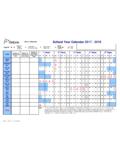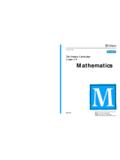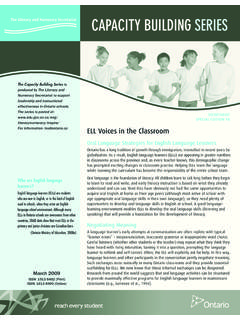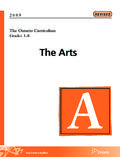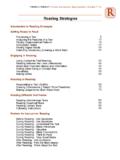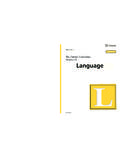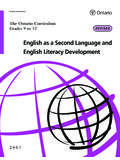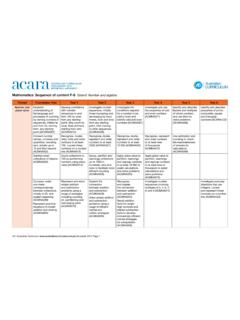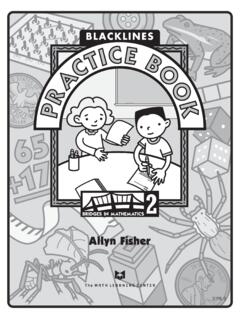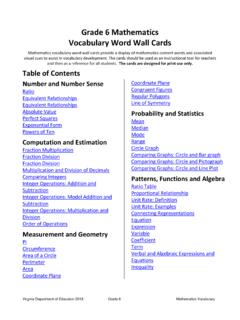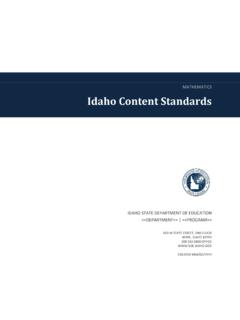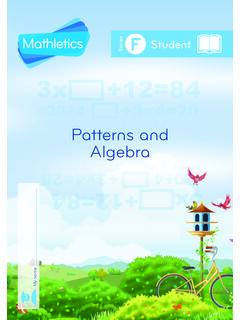Transcription of Focusing on the Fundamentals of Math
1 Focusing on the Fundamentals of MathA TEACHER S GUIDE This guide is intended to support teachers ongoing efforts in building students knowledge and skills in mathematics. It focuses attention on the content of expectations in The Ontario Curriculum, Grades 1 8: Mathematics, 2005 that deal with fundamental mathematics concepts and skills (specifically, expectations in the Number Sense and Numeration strand and expectations that relate to number properties in the Patterning and Algebra strand). The guide outlines steps to achieving the knowledge and skills described in these expectations and suggests how to make more timely connections that will better support student learning. A strong foundation in the concepts and skills emphasized here will prepare students for success in high school, and ensure that they have a set of essential skills for employment and responsible citizenship in the highly skilled at arithmetic requires the development of number sense alongside procedural and factual knowledge as well as the mathematical principles that govern how the operations are related to one another.
2 (Bruce & Chang, 2013, p. 14, citing Baroody & Dowker, 2003)2 What are the fundamental math concepts and skills? Fundamental math skills, and the concepts that underpin them, may be categorized according to the following framework: Working with numbers: Understanding and using numbers ( , being able to read, represent, count, order, estimate, compare, compose, decompose, and recompose numbers). Recognizing and applying understanding of number properties: Understanding how numbers behave in operations and drawing on that understanding to master math facts and perform calculations. Mastering math facts: Understanding and recalling math facts, using a variety of strategies. Developing mental math skills: Doing calculations in the mind, with little or no use of paper and pencil or calculator.
3 Developing proficiency with operations: Performing calculations with ease, precision, and consistency and with a general understanding of number and operations, number properties, and their appropriate application in problem is it important for students to master the Fundamentals of math?Understanding how numbers work is foundational to all aspects of mathematics. As students progress through the grades, they learn about different types of numbers and how those numbers behave when operations are applied to them. Recognizing and understanding number properties is foundational to arithmetic and need to be fluent with number facts in order to perform mathematical calcula-tions efficiently and accurately, whether mentally or by applying algorithms on paper.
4 The goal is for students to develop automaticity, which is the ability to use skills or perform mathematical procedures with little or no mental effort. Automaticity with math facts also supports students in critical thinking and problem more automatically a procedure can be executed, the less mental effort is required. Since each person has a limited amount of mental effort that he or she can expend at any one time, more complex tasks can be done well only when some of the subtasks are automatic.(National Research Council, 2001, p. 351)Most students learn math facts gradually, over a number of years, using tools such as manipulatives and calculators. Mastery comes with practice, and practice helps consoli date knowledge.
5 Students will draw on their ability to apply math facts with automaticity throughout secondary school, as they manipulate algebraic expressions and equations. Mental math skills involve the ability to perform mathematical calculations in the mind, without relying on pencil and paper. Mental math skills enable students to estimate 3answers to calculations, and so be able to work quickly on everyday problems and judge the reasonableness of answers calculated is important for students to become proficient in using the operations of addition, subtraction, multiplication, and division in the elementary grades. Even in today s technological age, people use calculations every day for example, to verify that they ve received correct change or to estimate how many cans of paint they need to paint a room.
6 In the early grades, students learn about operations with whole numbers, and this sets the stage for working with decimals, fractions , and integers later on. Though individual students may progress at different rates, generally speaking, addition/subtraction facts should be mastered by the end of Grade 3, and multiplication/division facts should be mastered by the end of Grade 5 (Chapin & Johnson, 2006) but students should continue to practise and extend their proficiency throughout the grades and in the context of learning in all the strands of the mathematics curriculum. How can educators help students master the Fundamentals ? Strategies help students find an answer even if they forget what was memorized.
7 Discussing math fact strategies focuses attention on number sense, operations, patterns, properties, and other critical number concepts.(O Connell & SanGiovanni, 2011, p. 5)Fluency with basic math facts is fostered through instruction that highlights strategies for remembering facts, focuses on making sense, and integrates math-fact learning into other aspects of math learning, such as developing computational skills. Repeated practice, or drill , by itself may improve speed, but it does not contribute to understanding and it is not sufficient to guarantee immediate recall. Strategies such as learning related math facts together for instance, 5 is half of 10 enable students to understand the inter-connectedness of math facts and also make it easier to remember them.
8 Children should learn their number facts. However, they would benefit from learning these facts by using an increasingly sophisticated series of strategies rather than by jumping directly to memorization.(Lawson, 2016, p. 4)Strategies that can help students commit basic facts to memory include: identifying the various ways in which math facts can be understood, such as + 1 , - 1 , + 2 , - 2 , + 10 , - 10 , doubles , making 10 , 2 or doubling , 10 , 5 ; learning about number properties as they notice patterns in addition and multiplica-tion for example, as students in the primary grades realize that two numbers added backward or forward give the same sum, they learn about the commutative property of addition; 4 looking for relationships between numbers for example: 3 5 is the same as 5 + 5 + 5, or half of 30, or one more than 7 + 7, or halfway between 10 and 20.
9 Representing operations performed on numbers in different ways for example, in concrete, pictorial, and symbolic ways; analysing results of operations for example, What happens when two odd numbers are added? ; practising by playing games, such as Domino Drop, Roll-O, and Over-Easy Doubles;1 and having frequent opportunities to practise. Educators observations and their conversations with students provide them with rich insight into the strategies that students are using and how effectively they are applying them. Conversations reveal whether students understand how they are performing com-putations and whether their answers make sense to them. Research shows that, for many students, timed testing may be less constructive, as it fosters math anxiety, which nega-tively impacts the students efficiency and accuracy.
10 As educators plan student learning experiences, it is important to focus on student under-standing and sense making, the interconnectedness of the categories, and the application of skills in problem-solving contexts both in and outside the classroom. The goal should be to provide opportunities for students to come to recognize, informally, how numbers and operations work. Only then should formal methods, such as algorithms, be introduced, modelled, and can educators use this guide to support students in learning the fundamental math concepts and skills?The following tables, for Grades 1 to 3, Grades 4 to 6, and Grades 7 and 8, outline a scope and sequence , from The Ontario Curriculum, Grades 1 8: Mathematics, 2005, for developing and mastering the Fundamentals , based on the framework outlined on page 2 of the present document.
